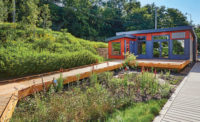A new industry report reveals that in order for green building to continue to gain market share at a comparable rate to the past decade, more far-reaching benefits need to be documented and demonstrated to organizational leadership for them to increase their level of green investments.
These include benefits across the spectrum of financial, environmental and social benefits—often referred to as the “triple bottom line.”
The report was released by McGraw-Hill Construction, part of The McGraw-Hill Cos., in the form of its latest SmartMarket Executive Brief. Titled “Determining the Value of Green Building Investments: A Perspective From Industry Leaders on Triple Bottom Line Decision Making,” it was created in partnership with URS, at the White House’s 2012 GreenGov Symposium.
The report provides the findings of qualitative research conducted by McGraw-Hill Construction through interviews with sustainability leaders in the education, health care, retail, manufacturing and federal government sectors on their perspectives about decision making for green building investments.
“To date, owners have acted on compelling benefits from their green investments, mainly savings in energy, water, waste and lowered operating costs,” said Harvey Bernstein, vice president of industry insights and alliances at McGraw-Hill Construction. “However, these are only a fraction of the advantages offered by green buildings—missing is a quantification of the full triple bottom line benefits from these investments, especially around the social benefits to human performance and well-being.”
The study includes recommendations on actions needed in the industry to accelerate green investments across the built environment. Those include:
• Evaluate social, environmental and financial goals together when making decisions on green building investments;
• Create green-building benchmarks through standardization and disclosure of operational building costs;
• Compile data and case studies that establish the value of nonfinancial benefits of green building;
• Create better tools using a more thorough, industry-consensus definition of lifecycle costing based on impacts across the triple bottom line;
• Assemble a public database of green project measures across the triple bottom line.
“The data confirm that sustainability is vital to business growth, for us and for our clients. The demand for business to demonstrate its ability to create value for all its stakeholders is paramount,” said Lidia Berger, vice president, Sustainable Practice Director – Facilities at URS. “URS understands how to design, implement and measure the value of sustainable investment. Most importantly, we can provide our clients with a measurable return on investment based on projects’ economic, social and environmental impacts.”
Through in-depth interviews with sustainability leaders, the report finds that organizations are using lifecycle cost analysis of operational savings to demonstrate the ROI of green and to justify green building projects. However, most respondents report there is a need for more data about the non-financial benefits of green to encourage their organizations to increase their investment in green building. The report also reveals the need for standardized measures that can fully capture the impact of green building across the triple bottom line.
The results of the study were presented as part of the Economic Valuation session at the White House’s 2012 GreenGov Symposium in Washington, D.C.



Post a comment to this article
Report Abusive Comment